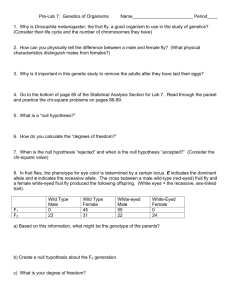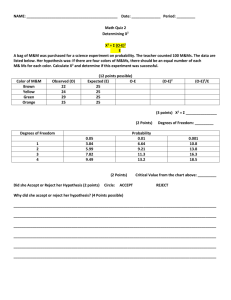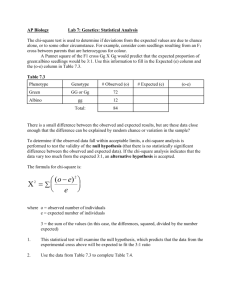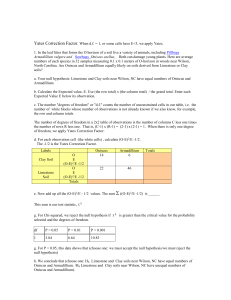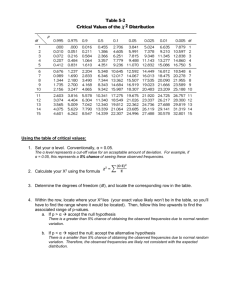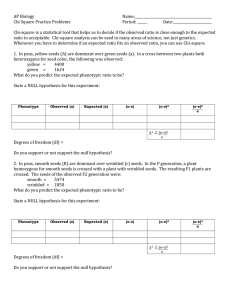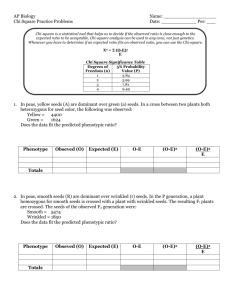date: ______ block
advertisement
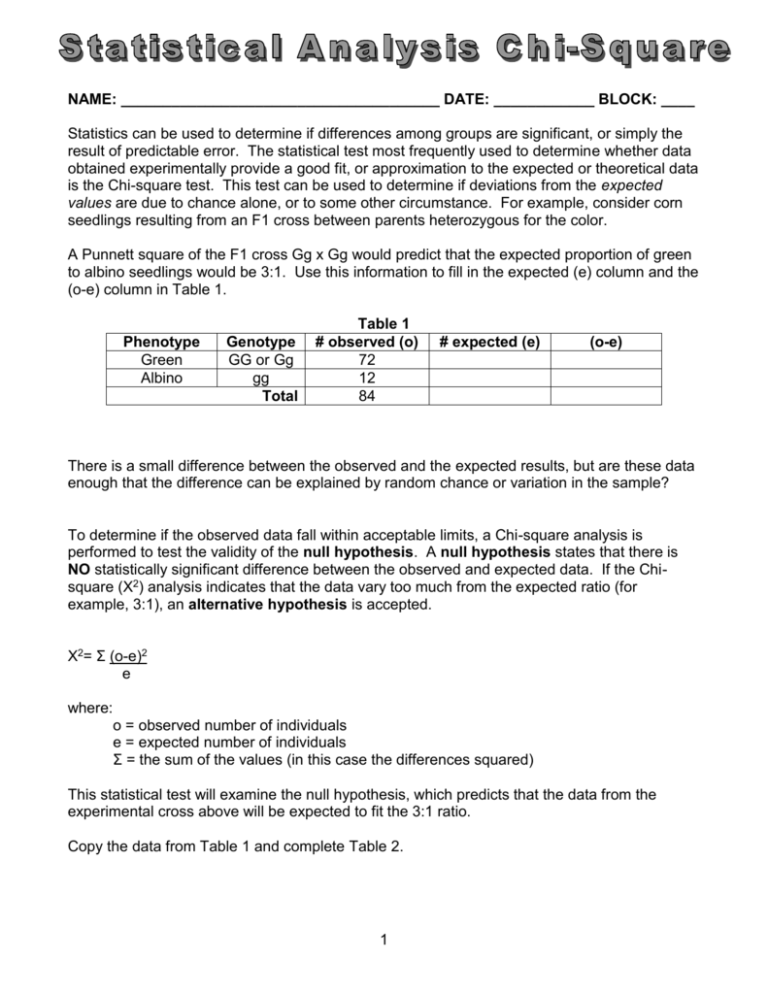
NAME: ______________________________________ DATE: ____________ BLOCK: ____ Statistics can be used to determine if differences among groups are significant, or simply the result of predictable error. The statistical test most frequently used to determine whether data obtained experimentally provide a good fit, or approximation to the expected or theoretical data is the Chi-square test. This test can be used to determine if deviations from the expected values are due to chance alone, or to some other circumstance. For example, consider corn seedlings resulting from an F1 cross between parents heterozygous for the color. A Punnett square of the F1 cross Gg x Gg would predict that the expected proportion of green to albino seedlings would be 3:1. Use this information to fill in the expected (e) column and the (o-e) column in Table 1. Phenotype Green Albino Genotype GG or Gg gg Total Table 1 # observed (o) 72 12 84 # expected (e) (o-e) There is a small difference between the observed and the expected results, but are these data enough that the difference can be explained by random chance or variation in the sample? To determine if the observed data fall within acceptable limits, a Chi-square analysis is performed to test the validity of the null hypothesis. A null hypothesis states that there is NO statistically significant difference between the observed and expected data. If the Chisquare (Χ2) analysis indicates that the data vary too much from the expected ratio (for example, 3:1), an alternative hypothesis is accepted. Χ2= Σ (o-e)2 e where: o = observed number of individuals e = expected number of individuals Σ = the sum of the values (in this case the differences squared) This statistical test will examine the null hypothesis, which predicts that the data from the experimental cross above will be expected to fit the 3:1 ratio. Copy the data from Table 1 and complete Table 2. 1 Table 2 Phenotype Genotype # observed (o) Green GG or Gg 72 Albino gg 12 Total Number Observed # expected (e) (o-e) (o-e)2 (o-e)2 e Χ2 = Σ (o-e)2 e 84 Your calculations should give you a value of Χ2 = 5.14. This value is then compared to the following table of critical values. Table 3: Critical Values for Chi-square distribution Degree of Freedom Probability (p) 1 2 3 4 0.05 3.84 5.99 7.82 9.49 0.01 6.64 9.21 11.3 13.2 5 11.1 15.1 How to use the Critical Values Table: Determine the degrees of freedom (df) for your experiment. It is the number of categories minus 1. Since there are 2 possible phenotypes, for this experiment the df = 2 samples -1 = 1. If the experiment had gathered data for a cross such as GgTt x GgTt there would be 4 possible phenotypes and 3 degrees of freedom. The p value we will always use is 0.05. Find the row where p = 0.05. Under the 1 df column the critical value is 3.84. What does this mean? If the calculated Chi-square value is greater than or equal to the critical value from the table, then the null hypothesis is rejected. In our example, Χ2 = 5.14 and 5.14 > 3.84, therefore we reject the null hypothesis. We reject that there is no significant difference between the observed and the expected data. In other words, chance alone cannot explain the difference between the observed and expected and something went “askew”. With a p=0.05, you can say that you are 95% sure that your data do not fit the expected 3:1 ratio. Since these data do not fit the expected 3:1 ratio, you must then consider reasons for this variation. Additional experimentation may need to be done. You may have to increase the sample size. 2 Practice Problem 1 In a study of incomplete dominance in tobacco seedlings, the following data was collected from a cross between two heterozygous (GY) plants. Table 4 Genotype GG GY YY Phenotype Green Yellowish-green Albino Total Observed 22 50 12 84 Use the table below to help you calculate Χ2 for these data. The use the Critical value table and decide whether you will reject or accept the null hypothesis. Table 5 Phenotype Genotype # observed (o) Green GG 22 Yellowishgreen Albino GY 50 YY 12 # expected (e) (o-e) (o-e)2 (o-e)2 e Χ2 = Σ (o-e)2 e Total Number Observed 1. How many degrees of freedom do you have? ___________ 2. Χ2 = ______________ 3. Referring to the critical values chart, what is the critical value for these data (use p=0.05)? 4. Can you accept or reject the null hypothesis? Explain why. 3 Practice Problem 2 An investigator observes that when pure-breeding long wing Drosophila are mated with purebreeding short wing flies, the F1 offspring have intermediate wing length. The F1 offspring are allowed to interbreed and the following results are obtained. Observed 230 long wings 510 intermediate wings 260 short wings 1. What is the genotype of the F1 intermediate winged flies? 2. Write a hypothesis describing the mode of inheritance of wing length in Drosophila (this is your null hypothesis). Complete Table 6: Table 6 Phenotype Genotype # observed (o) # expected (e) (o-e) (o-e)2 (o-e)2 e Χ2 = Σ (o-e)2 e Total Number Observed 3. How many degrees of freedom do you have? ___________ 4. Χ2 = ______________ 5. Referring to the critical values chart, what is the critical value for these data (use p=0.05)? 6. Can you accept or reject the null hypothesis? Explain why. 4

